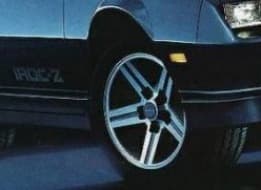Many thanks go to Jim Irace and Willie (Thirdgen.org History Moderator) for their help and contribution to this article. We’ve been wanting to do this for some time now, just never really got around to it. Well, seeming we’ve been getting approached more and more with questions pertaining to buying a used IROC and whether it’s “authentic” or not, we decided to write this article. Throughout the IROC-Z era, the basic look of the car looks the same. We’ll point out some things that differ with each model year IROC-Z along with what to look for with different options (i.e. 305 Throttle Body Injection versus 350 Tuned Port Injection).
What makes an IROC and IROC?
Well, after looking around for one, and seeing enough of them, you should be able to point out what is actually an IROC and what is not. We won’t kid you here. There are several “IROC” wannabe’s out there – ones who make a third generation camaro “look” and even drive like an “authentic” IROC-Z. Some people do a really good job, some people do not. The best way to tell if the car is an “authentic” IROC-Z is to look at the VIN number and, most importantly, the RPO codes (granted the “faker” didn’t swap out the center console with a real IROC-Z, then you would have to decode all of the numbers and figure out if the vehicle is indeed an IROC.) Just like the Z-28′s, all IROC-Zs came with black painted headlight inserts. But not like Z-28′s, the IROC-Z’s ground effects were the same color as the body, versus the two tone paint schemes of the Z-28.
VIN number
The VIN number is located on the dash, drivers side, in plain view from the outside of the windshield. Decoding the VIN will tell the basics of the car and the engine it is equipped with. Not much to really tell, unless the VIN states the car was a V6 and the seller says it’s an IROC. The IROC-Z always came with a V8.
RPO codes
The RPO codes are located on a sticker, usually located in the center console/passenger side wall. The RPO code to look for in a 1985 to 1987 IROC-Z is B4Z. The RPO code to look for in a 1988 to 1990 IROC-Z is Z28 (since the IROC-Z “replaced” the Z-28 from 1988 to 1990, GM elected to use the Z28 RPO code for that option from 1988 to 1990). As a little tidbit, the Z-28 resumed production AS a Z-28 for the 1991 model year as GM’s licensing for IROC ended December 31st, 1989. The limited number of 1990 IROC-Z’s is accounted for the number of cars produced, under the IROC license, until December 31, 1989 for the 1990 model year.
For Starters:
To narrow down what model year “sub era” of IROC-Z you are looking at, play close attention to the IROC-Z logo on the door. From 1985 to 1987, the logo was towards the front of each door, whereas from 1988 to 1990 (if the car does not have the ‘sticker delete’ option), they were towards the rear of each door.
Note the striping layout between each ‘sub era.’ From 1985 to 1987, the stripes were arranged where the black stripe was on the bottom of the two (silver on top as noted in the photo below). From 1988 to 1990, this black stripe was on the top of the two (again, if the car does not have the ‘sticker delete’ option.)
Also note the wheel styles. A all 1985 to 1987 IROC-Zs had the 16″ aluminum wheels with the single (wider) line through each spoke as standard. From 1988 to 1990, the 16″ aluminum wheel was now an option, however, all later style IROC-Z wheels had two (thinner lines) through each spoke whether it was 15″ or 16″ (except for 1988 15″ standard wheel – we’ll cover this later).

The IROC (International Race Of Champions) began using the Camaro as the official vehicle. To commemorate this, Chevy made an IROC model for the Camaro. The IROC-Z was option B4Z on the option sheet and could only be ordered with the Z28 option package. The ride height was lower than a standard Z-28, and featured performance-calibrated front struts and springs, Bilstein rear shocks and 16 inch aluminum wheels with Goodyear Eagle 245/50/16 tires.
This new performance icon boasted skidpad numbers within the range of .90 g. The top offering under the hood was the brand new TPI 305 (LB9) which boasted 215 horsepower and 275 ft/lbs of torque. Recipients of this engine wore the tpi.gif (1568 bytes) badge. This was the most powerful 305 automatic ever offered in the IROC. The 190 horsepower HO 4bbl 305 and the standard output 155 horse LG4 were the other available motors.
The IROC also came with a redesigned front fascia with a more rounded appearance and a deeper chin spoiler with lower ground effects. The new fake hood louvers were introduced on the Z28 and IROC. The IROC was available in Yellow, Bright Blue Metallic, Black, Silver Metallic and Red.
A ‘unique’ feature of the 1985 IROC-Z, is that there is no third brake light. Neither near the top of the hatch window, nor in the rear spoiler.